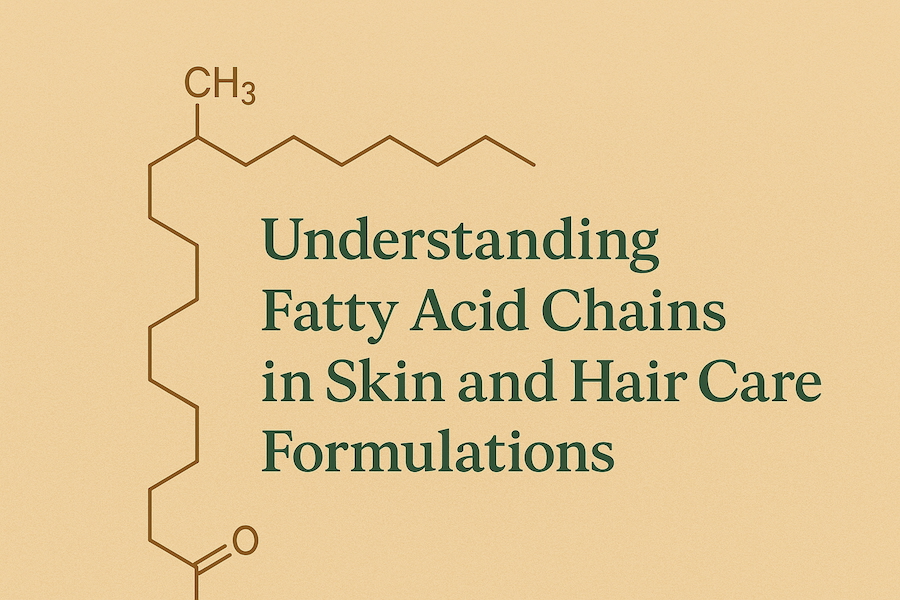
Fatty Acid Chains in Skin and Hair Care Formulations
When it comes to natural oils and butters used in cosmetic formulation, one of the most important aspects to understand is fatty acid chains. Fatty acids are the building blocks of plant oils, butters, and waxes, and their chain length and structure influence how an ingredient performs on the skin and hair. In this article, we talked about Understaning Fatty Acids in Skin and Hair Care.
What Are Fatty Acid Chains?
A fatty acid is made up of a hydrocarbon chain attached to a carboxyl group (-COOH). The “chain” refers to the length of connected carbon atoms, which can range from short (just a few carbons) to very long (over 20 carbons). These chains are categorized into three groups:
-
Short-chain fatty acids (SCFAs): Fewer than 6 carbons
-
Medium-chain fatty acids (MCFAs): 6–12 carbons
-
Long-chain fatty acids (LCFAs): 13–21 carbons
-
Very-long-chain fatty acids (VLCFAs): More than 22 carbons
In cosmetic formulations, most plant oils and butters are rich in medium to long-chain fatty acids, though some also contain shorter chains that behave differently on the skin and hair.
Saturation and Structure
Fatty acids can also differ in saturation:
-
Saturated fatty acids: No double bonds (e.g., stearic, palmitic). They create solid textures like cocoa butter or shea butter and provide occlusive, protective layers.
-
Monounsaturated fatty acids: One double bond (e.g., oleic). They penetrate the skin well, providing softness and flexibility.
-
Polyunsaturated fatty acids: Multiple double bonds (e.g., linoleic, linolenic). They are lightweight, fast-absorbing, and beneficial for barrier repair, but can be more prone to oxidation.
How Chain Length Affects Skin and Hair Care
Short-Chain Fatty Acids
-
Examples: Caproic acid (rare in plants), but also present in trace amounts in certain plant oils.
-
Behavior: Very small molecules that penetrate quickly. In skincare, they feel lightweight but are less common in high percentages in plant oils.
Medium-Chain Fatty Acids
-
Examples: Caprylic (C8), capric (C10), lauric (C12).
-
Plant Sources: Coconut oil, babassu oil.
-
Behavior: Easily absorbed and provide antimicrobial activity. Lauric acid, abundant in coconut and babassu oils, has natural antibacterial properties—helpful for acne-prone skin and scalp balance.
Long-Chain Fatty Acids
-
Examples: Palmitic (C16), stearic (C18), oleic (C18:1).
-
Plant Sources: Shea butter, cocoa butter, mango butter, olive oil.
-
Behavior: Provide structure and emollience. They form protective films, reduce transepidermal water loss, and give creams and butters their rich, cushiony feel. Stearic acid, for example, is excellent for thickening lotions and conditioners.
Very-Long-Chain Fatty Acids
-
Examples: Behenic acid (C22), lignoceric acid (C24).
-
Plant Sources: Moringa oil (behenic), peanut oil, jojoba oil (contains long-chain wax esters).
-
Behavior: Create a waxy, protective barrier. They are particularly beneficial in hair conditioners for smoothing and reducing friction, and in skincare for locking in moisture.
Fatty Acid Chains in Topical Formulations
For Skin
-
Short/Medium Chains: Absorb quickly, provide lightweight hydration, antimicrobial protection (great for acne-prone or oily skin).
-
Long Chains: Deliver deep moisturization and barrier support (ideal for dry, mature, or sensitive skin).
-
Very Long Chains: Add occlusion, reduce water loss, and enhance formulation stability.
For Hair
-
Short/Medium Chains: Penetrate the hair shaft to improve flexibility and reduce breakage (e.g., coconut oil with lauric acid).
-
Long Chains: Coat hair strands, improving smoothness, reducing frizz, and adding shine.
-
Very Long Chains: Form a protective layer on the hair cuticle, reducing damage from heat, styling, and environmental stress.
Use our Quick Reference Chart for Fatty Acid Chains in Plant Oils and Butters
Why Cosmetic Formulators Need to Understand Fatty Acid Chains
-
Texture & Sensory: Chain length impacts whether an ingredient feels light, silky, waxy, or heavy.
-
Performance: Determines whether the ingredient penetrates deeply or stays on the surface for protection.
-
Formulation Balance: Choosing the right mix of fatty acid chains ensures products suit different skin and hair types—balancing hydration, nourishment, and protection.
A skilled cosmetic formulator understands fatty acid chains to design vegan, plant-based products that meet specific skin and hair needs.
Fatty acid chains are much more than just chemical structures. They define how plant oils and butters behave in topical formulations, whether they sink in quickly to soften, create a long-lasting barrier, or provide antimicrobial support. A skilled cosmetic formulator understands fatty acid chains to design vegan, plant-based products that meet specific skin and hair needs.
You might also like

